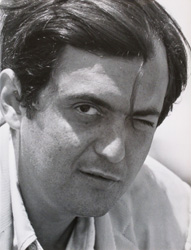May 11th -- June 11th, 2011
Reception: May 14, 2011 4-6PM
On May 11, Craig Krull Gallery will open its fourth solo exhibition of the work of Robert Weingarten. In his previously exhibited bodies of work, Weingarten's photographic practice has been characterized by the proposition of a thesis that is tested and explored via a rigorous photographic methodology of the artist's own device. In his 6:30am series, Weingarten set out to demonstrate that the mind develops visual stereotypes and assumes that the sky and ocean are generally blue, when in actuality, they are a constantly changing array of colors. He set up a tripod and made exposures at precisely 6:30 am every day for a year from the exact same spot, using the same aperture and film. Weingarten's "experiment" produced an extraordinary series of images of the Santa Monica Bay at sunrise-- with sky and water ranging in hue from pink to orange, and green to violet. Weingarten's next project, Palette Series, expanded upon a question raised during the creation of his 6:30am photographs. The artist wondered how local light affected the palettes of painters. He arranged to visit the studios of noted artists such as Ed Moses, Jasper Johns, Ed Ruscha, Chuck Close and many others, photographing extreme details of their palettes and enlarging them to dramatic proportions. Although he did not recognize a direct correlation of palettes to local light, he reveled in the ironic ability of photography to further abstract painting.
In his current body of work, entitled Portraits Without People, Robert Weingarten addresses the very nature of the centuries old tradition of portraiture by posing the question, "Can you express a person's being and character photographically without showing them?" He began making his own portrait by compositing images of objects and places of personal significance; his violin, his childhood home, a calculator, and other items. Julian Cox, curator of Weingarten's exhibition of this work at The High Museum in Atlanta, wrote, "Weingarten adds to the tradition [of photocollage] by moving beyond the instant of the photographic moment to conjure a more synthetic, impressionistic kind of picture that blurs the boundaries between fact and fantasy." In order to create a resonant series of these "portraits without people", Weingarten recognized that his subjects should be prominent individuals of high accomplishment and general public recognition. He sought out icons of our society such as Stephen Sondheim, Frank Gehry, and Joyce Carol Oates, asking them for a list of 10 objects and places that define who they are. Weingarten made photographs of the items on each list, then created the individual portraits by layering his images digitally. As Julian Cox observed, "light passes through specific objects and elements in the composition, creating a new kind of depth perception and the suggestion of a three-dimensional space." Weingarten has identified this digital practice and work as a "translucent composite."
In addition to the exhibition and catalogue at the High Museum in 2010, Weingarten's Portraits Without People will be exhibited at the Smithsonian Institution in 2012. A reception for the artist will be held at Craig Krull Gallery on Saturday, May 14, 4-6pm.
Concurrently, the gallery will present an exhibition of photographic portraits by Richard C. Miller created from the 1940s - 1960s in Southern California. In the spring of 2009, Miller's career was given long overdue recognition in the form of an exhibition at the Getty Museum. As a practitioner of the exceptionally stable-- yet technically difficult-- color process known as carbro printing, Miller's work was positioned adjacent to an exhibit of one of the masters of that technique-Paul Outerbridge. The exhibition at Craig Krull Gallery will feature a selection of carbro prints from the 40s, including a very early image of Norma Jean Dougherty (Marilyn Monroe) on the beach. In addition, the exhibit will include a number of vintage prints of film luminaries photographed very unconventionally, sometimes in extreme close-up, such as in his haunting, almost surreal image of Stanley Kubrick with one eye closed, and the other glaring and direct.

